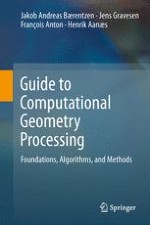2012 | OriginalPaper | Buchkapitel
14. Triangle Mesh Generation: Delaunay Triangulation
verfasst von : Jakob Andreas Bærentzen, Jens Gravesen, François Anton, Henrik Aanæs
Erschienen in: Guide to Computational Geometry Processing
Verlag: Springer London
Aktivieren Sie unsere intelligente Suche, um passende Fachinhalte oder Patente zu finden.
Wählen Sie Textabschnitte aus um mit Künstlicher Intelligenz passenden Patente zu finden. powered by
Markieren Sie Textabschnitte, um KI-gestützt weitere passende Inhalte zu finden. powered by
